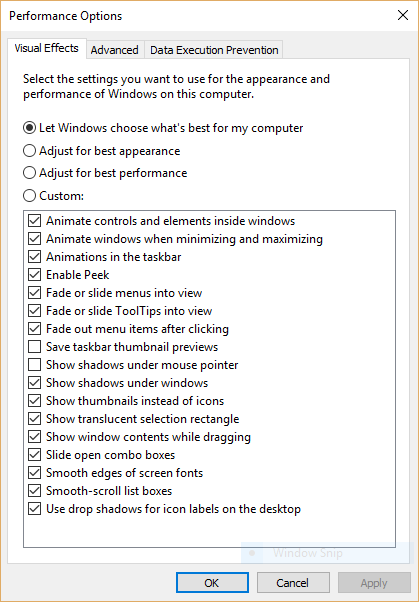How can I enhance my slow PC's performance running Windows 10?
By Rene | 21/Nov/2024
Windows 10 runs pretty fast, but some users who have updated Windows 10 for one year or so are reporting its slowing down tendency, like an old cart missing at least one wheel. To speed up a slow Windows performance, here are quick fixes to help you get the most out of Windows 10. Some of them need to be done once for all, and the others require constant maintenance.
Once-For-All Speeding Up Windows 10 Tricks
Disable shadows, animations, and visual effects
Windows 10 also brought several beautiful new features and settings, like shadows, animations and visual effects, which can negatively impact performance on the slow running or old PCs. But it is easy to switch them off.
Step
1.On the search box, type sysdm.cpl and press Enter.
2.In the System Properties dialog box, click the Advanced tab and click Settings in the Performance section. The Performance Options dialog box lets you turn off effects that might be slowing down Windows 10.

You can check the box follow the images if you have no idea about what to turn off.
Optimization Power Settings
If you’re using Windows 10’s Power saver plan, you’re slowing down your PC, which reduces your PC’s performance in order to save energy. Changing your power plan from Power saver to High performance or Balanced will increase PC performance instantly.
Step
1.Go to Control Panel, select Hardware and Sound > Power Options.
2.Choose Balanced saver.(recommended)
3.To reach High performance settings, click Show additional plans.
Weekly Maintenance to Enhance Slow PC Performance
Turn Off Startup Programs
One of the most common reasons your Windows 10 PC may feel lagged is you've got too many programs running when starting up the PC-- programs that you may never use, or only rarely use. Disabling them running on startup can increase computer speed and performance.
Step
1.Launch Task Manager by press Ctrl+Shift+Esc on the keyboard.
2.Click the Startup tab, stop a program or service from launching at startup, right-click it and select Disable, to speed up Windows 10 boot up.
Besides Programs, there are some services out there needing disabled or delayed. But it is not easy to decide if turning them off would stop some system partition functioning. Therefore, there is a better third-party tool helping you manage the startup items—Neptune SystemCare Ultimate. Including on the list is each program's name as well as its publisher, services and function, whether it's enabled to run on startup, and its Boot time, which is how much it slows down Windows 10 when the system starts up.

Startup Manger prevents unnecessary apps and services from launching at startup -- you can always run the application after launch. Also, if you later decide you want it to launch at startup, you can just recover it on the Records section.
Speed Up Your Processor
If you open a lot of files, apps and windows and never shut them down until you finish your day, your slow running processor is definitely reducing your work efficiency. Every time you feel your computer stumbling, you can relieve the burden of your processor by closing down the less urgent programs and files.
Step
1.Open Task Manager, and choose Process tab.
2.Click on the apps you do not need right now and then hit End Task button below.

Or you can speed up processor with a much easier way— one click on the Neptune Floating tray and done.
Remove Bloatware
Sometimes the biggest elements slowing down your PC isn't Windows 10 itself, but bloatware or adware that takes up CPU and system resources. You can always use the built-in tool, Windows Defender to help you get rid of that.
Step
1.Type Windows Defender in the search box, press Enter.
2.Click Scan Now. Windows Defender will look for malware and remove any it finds.

Try just some of these tricks, and you'll find that your Windows 10 PC gets improved performance and speed.